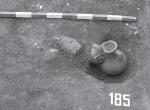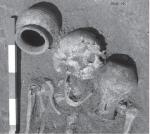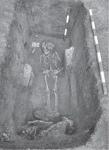Summary (English)
EXPLORATIONS NEAR BALCHIK (Lyudmila Doncheva–Petkova – ldoncheva_petkova@abv.bg, Kircho Apostolov, Evgenia Komatarova–Balinova) Fourty-seven graves (22 cremation graves and 25 inhumation graves) were discovered on an area of 200 sq. m and the total number of the burials in the necropolis reached 222. Cremation burial No. 188 is in a burial chamber of stones. The rest of cremation burials were pits with grave markers, 25 – 75 cm in depth, measuring from 30 – 40 cm to 70 – 90 cm. Graves Nos. 180 – 183 were arranged close to each other and are surrounded with stones. The graves were oriented north – south and contained cremated bones, ceramic vessels, iron buckles, rings, small knives, a bronze buckle and two arrowheads. A child and an adult were buried in grave No. 176. Most of the graves contained burials of adults from 20 to 40 years old. There are cremated and not-cremated animal and bird bones and charcoal placed in the graves. Grave markers of the inhumation burials were attested in graves Nos. 208 and 221. In some cases the burial pits were covered or surrounded with stones. Cist grave No. 198 belonged to a child. The burial pits were 1.90 – 2.40 m long, 0.50 – 1.10 m wide and 20 – 80 cm deep. The deceased were oriented north – south, in three burials the deceased were oriented east – west, in two burials the deceased were oriented west – east and in one child burial the deceased was oriented south – north. The deceased lay supine. Artificial deformation was attested in several child skulls. Dismembered ox, cows, sheep and lambs were found in the graves. There were eggshells in two child graves. The grave goods include pottery (pots, jugs, a dish, a pail), iron and bronze buckles, rings, small knives, a firesteel, beads, earrings, a silver pendant and a pierced coin of the 4th century AD. According to the date of the finds, the proto-Bulgarian necropolis began to function in the first decades immediately after the foundation of the First Bulgarian Kingdom in AD 681.
- Lyudmila Doncheva–Petkova - Archaeological Institute and Museum
- Kircho Apostolov - Museum of History - Omurtag
- Evgenia Komatarova–Balinova - Archaeological Institute with Museum
Director
Team
Research Body
- Archaeological Institute with Museum
- Museum of History - Omurtag






![Download [PDF]](/excavation/skins/fasti/images/results/download_sml.png)

